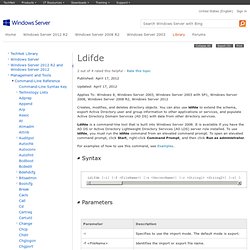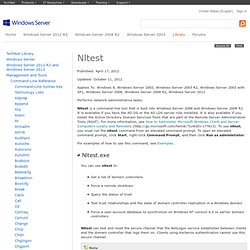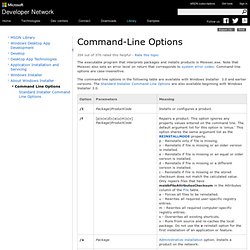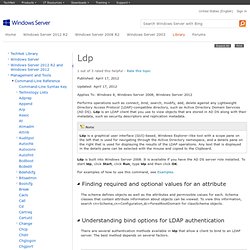

Freedisk. Ldifde. Published: April 17, 2012 Updated: April 17, 2012 Applies To: Windows 8, Windows Server 2003, Windows Server 2003 with SP1, Windows Server 2008, Windows Server 2008 R2, Windows Server 2012 Creates, modifies, and deletes directory objects.

You can also use ldifde to extend the schema, export Active Directory user and group information to other applications or services, and populate Active Directory Domain Services (AD DS) with data from other directory services. Ldifde is a command-line tool that is built into Windows Server 2008. For examples of how to use this command, see Examples. Ldifde [-i] [-f <FileName>] [-s <ServerName>] [-c <String1><String2>] [-v] [-j <Path>] [-t <PortNumber>] [-d <BaseDN>] [-r <LDAPFilter>] [-p <Scope>] [-l <LDAPAttributeList>] [-o <LDAPAttributeList>] [-g] [-m] [-n] [-k] [-a <UserDistinguishedName><Password>] [-b <UserName><Domain><Password>] [-?]
Ldifde -d dc=fabrikam,dc=com -r (objectClass=User) -l distinguishedname,cn,givenname,sn,telephone –f ldifde.txt. Nltest. Published: April 17, 2012 Updated: October 11, 2012 Applies To: Windows 8, Windows Server 2003, Windows Server 2003 R2, Windows Server 2003 with SP1, Windows Server 2008, Windows Server 2008 R2, Windows Server 2012 Performs network administrative tasks.

Nltest is a command-line tool that is built into Windows Server 2008 and Windows Server 2008 R2. It is available if you have the AD DS or the AD LDS server role installed. For examples of how to use this command, see Examples. You can use nltest to: Get a list of domain controllers Force a remote shutdown Query the status of trust Test trust relationships and the state of domain controller replication in a Windows domain Force a user-account database to synchronize on Windows NT version 4.0 or earlier domain controllers Nltest can test and reset the secure channel that the NetLogon service establishes between clients and the domain controller that logs them on. Netsh Technical Reference. Command-Line Options. The executable program that interprets packages and installs products is Msiexec.exe.

Note that Msiexec also sets an error level on return that corresponds to system error codes. Command-line options are case-insensitive. The command-line options in the following table are available with Windows Installer 3.0 and earlier versions. The Standard Installer Command-Line Options are also available beginning with Windows Installer 3.0.
The options /i, /x, /f[p|o|e|d|c|a|u|m|s|v], /j[u|m], /a, /p, /y and /z should not be used together. To install a product from A:\Example.msi, install the product as follows: msiexec /i A:\Example.msi Only public properties can be modified using the command line. To install a product with PROPERTY set to VALUE, use the following syntax on the command line. Correct syntax: msiexec /i A:\Example.msi PROPERTY=VALUE Incorrect syntax: msiexec /i PROPERTY=VALUE A:\Example.msi Property values that are literal strings must be enclosed in quotation marks. Ldp. Published: April 17, 2012 Updated: April 17, 2012 Applies To: Windows 8, Windows Server 2008, Windows Server 2012 Performs operations such as connect, bind, search, modify, add, delete against any Lightweight Directory Access Protocol (LDAP)-compatible directory, such as Active Directory Domain Services (AD DS).

Ldp is an LDAP client that you use to view objects that are stored in AD DS along with their metadata, such as security descriptors and replication metadata. Ldp is built into Windows Server 2008. For examples of how to use this command, see Examples. The schema defines objects as well as the attributes and permissible values for each. There are several authentication methods available in ldp that allow a client to bind to an LDAP server.
Example 1: Add a new object to an LDAP directory To add a user to Active Directory by using ldp: